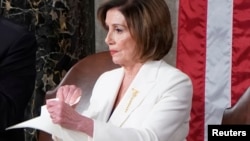An edited video of U.S. House Speaker Nancy Pelosi has raised questions about social media and political campaigns in the United States.
The video was produced last week after President Donald Trump’s State of the Union speech. The video shows Pelosi repeatedly tearing up a printed copy of the speech while the president spoke.
Trump posted the edited video on Twitter.
Pelosi did tear the pages of her copy of the speech. But she did so only after Trump finished speaking – not during the address as the video shows.
Pelosi’s office asked Twitter and Facebook to take down the video. Both companies refused to do so.
Researchers worry the video’s “selective editing” could mislead people.
“Selective editing” is a term for editing or changing videos in a way that does not show what really happened. Such recordings are sometimes called “cheapfake” videos.
Researchers fear the number of “cheapfakes” could increase if social media companies do not identify or make rules about such videos.
The United States has a long history of political candidates showing their opponents in a negative light. Thomas Jefferson and John Adams attacked each other in newspaper advertisements over 200 years ago.
In 1960, John F. Kennedy’s campaign used an ad showing different images of Richard Nixon sweating and looking weak.
In some ways, the edited video of House Speaker Pelosi is not unusual. What is different now, says Clifford Lampe, is how widely such videos can spread in such a short time. Lampe is a professor of information at the University of Michigan.
“The difference now is that the campaigns themselves, the president of (the) U.S. himself, is able to disseminate these pieces of media to the public,” he said. Lampe added that political candidates “no longer” have to work “with media outlets.”
Facebook, Google and Twitter have reported on their efforts reduce disinformation on their services. The hope is to avoid some of the backlash created by social media misinformation during the U.S. elections four years ago.
But the video of Pelosi does not violate existing policies, both Twitter and Facebook said.
Facebook has rules that ban what are known as “deepfake” videos. Such videos use artificial intelligence, or AI, technology to make it seem like someone “said words that they did not actually say.”
Researchers say the Pelosi video is a “cheapfake” video, a video that has been changed without the use of AI.
Cheapfakes are much easier to create and are more common than deepfakes, notes Samuel Woolley. He is director of propaganda research at the Center for Media Engagement at the University of Texas.
The Pelosi video is “deliberately designed to mislead and lie to the American people,” Pelosi deputy chief of staff Drew Hammill tweeted last week. He criticized Facebook and Twitter for not taking down the video from the social media services.
Andy Stone, who works for Facebook, reacted to Hammill’s comments on Twitter. Stone wrote, “Sorry, are you suggesting the President didn’t make those remarks and the Speaker didn’t rip the speech?”
Speaking with The Associated Press, Stone confirmed that the video did not violate the company’s policy. In order to be taken down, the video would have had to have been created with newer, more advanced technology. It would have also possibly tried to show Pelosi saying words that she did not say.
Twitter did not remove the video either. It pointed toward a blog post that says the company plans to start identifying tweets that contain “synthetic and manipulated media.” The new policy will take effect on March 5.
U.S. law does not say much about cheapfakes. Social media companies generally police their own websites.
A law, section 230 of the Communication Decency Act, protects technology companies from most legal action related to the information posted on their sites.
Most social media companies now ban violent videos and videos that could cause real-world harm. In recent years, Facebook, Twitter and Google’s YouTube have received criticism about offensive videos that have appeared on their sites. The companies sometimes remove the videos. Other times, they leave the videos on their sites, pointing to the right to freedom of expression.
The future of misinformation through social media is unclear. Jennifer Grygiel, an assistant professor at Syracuse University, called for laws to better govern social media in cases of political propaganda.
However, this proposal has some weaknesses, she admits. One difficulty is that the “very people who will be regulating them [social media sites] are the same ones using them [social media sites] to get elected.”
I’m John Russell.
And I’m Ashley Thompson.
Rachel Lerman reported on this story for The Associated Press. John Russell adapted it for VOA Learning English. George Grow was the editor.
________________________________________________________
Words in This Story
edit – v. to change or amend something for publication
page – n. a piece of paper
negative – adj. showing or talking about the bad qualities of someone or something
sweat – v. to release small, wet droplets from the skin
disseminate – v. to cause (something, such as information) to go to many people
backlash – n. a strong public reaction against something
deliberately – adv. in a way that is meant or planned
chief of staff – n. the top officer of a service
synthetic – adj. not real; related to a copy of a natural product; untrue or false
manipulate – v. to operate in a skillful way; to control of influence something unfairly
We want to hear from you. Write to us in the Comments Section.







